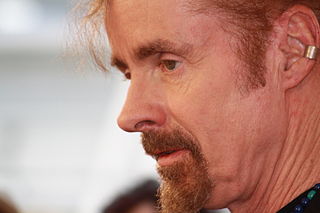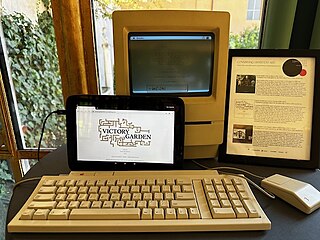
Hypertext is text displayed on a computer display or other electronic devices with references (hyperlinks) to other text that the reader can immediately access. Hypertext documents are interconnected by hyperlinks, which are typically activated by a mouse click, keypress set, or screen touch. Apart from text, the term "hypertext" is also sometimes used to describe tables, images, and other presentational content formats with integrated hyperlinks. Hypertext is one of the key underlying concepts of the World Wide Web, where Web pages are often written in the Hypertext Markup Language (HTML). As implemented on the Web, hypertext enables the easy-to-use publication of information over the Internet.

Thomas Coraghessan Boyle is an American novelist and short story writer. Since the mid-1970s, he has published nineteen novels and more than 150 short stories. He won the PEN/Faulkner award in 1988, for his third novel, World's End, which recounts 300 years in upstate New York.
Hypertext fiction is a genre of electronic literature, characterized by the use of hypertext links that provide a new context for non-linearity in literature and reader interaction. The reader typically chooses links to move from one node of text to the next, and in this fashion arranges a story from a deeper pool of potential stories. Its spirit can also be seen in interactive fiction.

Shelley Jackson is an American writer and artist known for her cross-genre experimental works. These include her hyperfiction Patchwork Girl (1995) and her first novel, Half Life (2006).
Michael Joyce is a retired professor of English at Vassar College, New York, US. He is also an important author and critic of electronic literature.
Electronic literature or digital literature is a genre of literature where digital capabilities such as interactivity, multimodality or algorithmic text generation are used aesthetically. Works of electronic literature are usually intended to be read on digital devices, such as computers, tablets, and mobile phones. They cannot be easily printed, or cannot be printed at all, because elements crucial to the work cannot be carried over onto a printed version.

Andrew Sean Greer is an American novelist and short story writer. Greer received the 2018 Pulitzer Prize for Fiction for his novel Less. He is the author of The Story of a Marriage, which The New York Times has called an "inspired, lyrical novel", and The Confessions of Max Tivoli, which was named one of the best books of 2004 by the San Francisco Chronicle and received a California Book Award.
Edward Falco is an American author, playwright, electronic literature writer, and new media editor.

afternoon, a story, spelled with a lowercase 'a', is a work of electronic literature written in 1987 by American author Michael Joyce. It was published by Eastgate Systems in 1990 and is known as one of the first works of hypertext fiction.

Victory Garden is a work of electronic literature by American author Stuart Moulthrop. It was written in Storyspace and first published by Eastgate Systems in 1991. Victory Garden is one of the earliest examples of hypertext novels, and is notable for being very inventive and influential in its genre. It is often discussed along with Michael Joyce's afternoon, a story as an important work of hypertext fiction.

Lawrence F. McCaffery Jr. is an American literary critic, editor, and retired professor of English and comparative literature at San Diego State University. His work and teaching focuses on postmodern literature, contemporary fiction, and Bruce Springsteen. He also played a role in helping to establish science fiction as a major literary genre.
Stuart Moulthrop is an innovator of electronic literature and hypertext fiction, both as a theoretician and as a writer. He is author of the hypertext fiction works Victory Garden (1992), which was on the front-page of the New York Times Book Review in 1993, Reagan Library (1999), and Hegirascope (1995), amongst many others. Moulthrop is currently a Professor of Digital Humanities in the Department of English, at the University of Wisconsin–Milwaukee. He also became a founding board member of the Electronic Literature Organization in 1999.
Eastgate Systems is a publisher and software company headquartered in Watertown, Massachusetts, which publishes hypertext.

Robert Arellano is an American author, musician and educator from Talent, Oregon. His literary production includes pioneering work in electronic publishing, graphic-novel editions for Soft Skull Press/Counterpoint, and five novels published by Akashic Books. His guitar-playing for Bonnie 'Prince' Billy is featured on 'I See a Darkness', which Pitchfork magazine named one of the Top 10 albums of the 1990s, and since the 1980s he has been writing and recording songs for solo projects and his group Havanarama.
Marjorie Coverley Luesebrink was an American writer, scholar, and teacher. Writing hypermedia fiction under the pen name M.D. Coverley, she is best known for her epic hypertext novels Califia (2000) and Egypt: The Book of Going Forth by Day (2006). A pioneer born-digital writer, she is part of the first generation of electronic literature authors that arose in the 1987–1997 period. She was a founding board member and past president of the Electronic Literature Organization and the first winner of the Electronic Literature Organization Career Achievement Award, which was named in her honor. Lusebrink was professor emeritus, School of Humanities and Languages at Irvine Valley College (IVC).

Samantha Gorman is an American game developer known for her combination of narrative, theatricality and gaming in VR environments, and for introducing gestural interactions in touchscreen narratives. She has won multiple awards for her work, both in the field of games and in electronic literature and new media writing. Gorman co-founded the computer art and games studio Tender Claws in 2014 and has been an assistant professor at Northeastern University since 2020.
King of Space is a work of electronic literature by author Sarah Smith. This interactive narrative is set in a collapsing solar system aboard an abandoned starship, where an escaped terrorist encounters the last star-captain and his ship's Priestess. The story weaves elements of gaming into a dark science-fictional ritual of fertility and regeneration.
Its Name Was Penelope is a hypertext fictional story created by Judy Malloy and published in 1993 by Eastgate Systems. The work makes use of digital elements such as randomized passages to tell the story of the main character's life.

Uncle Buddy's Phantom Funhouse is an early multimedia hypermedia text written by John McDaid and released by Eastgate Systems in 1993. The main portion of Funhouse was written for Macintosh's HyperCard app, but portions of the hypermedia novel are also contained in the original box. The use of transmedia storytelling, meta-fiction, and epistolary format makes this a potential early example of an alternate reality game.











